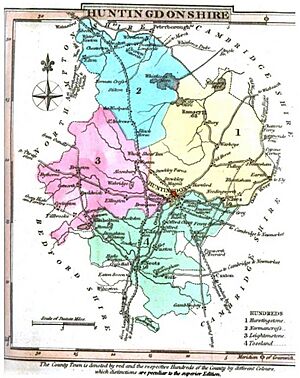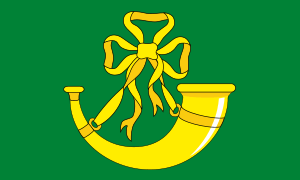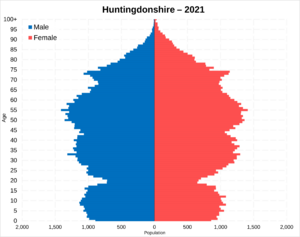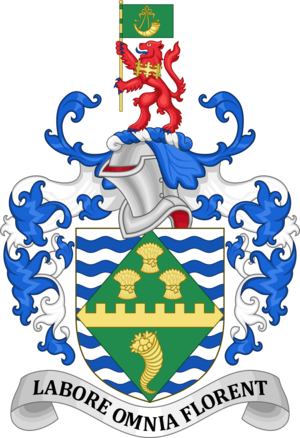Huntingdonshire facts for kids
Quick facts for kids
Huntingdonshire
|
|
|---|---|
|
Non-metropolitan district
|
|

Huntingdon, the historic county town of Huntingdonshire
|
|
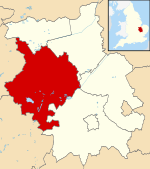
Huntingdonshire shown within Cambridgeshire
|
|
| Sovereign state | United Kingdom |
| Country | England |
| Region | East of England |
| Non-metropolitan county | Cambridgeshire |
| Status | Non-metropolitan district |
| Admin HQ | Huntingdon |
| Incorporated | 1 April 1974 |
| Government | |
| • Type | Non-metropolitan district council |
| • Body | Huntingdonshire District Council |
| Area | |
| • Total | 352.3 sq mi (912.5 km2) |
| Area rank | 35th (of 326) |
| Population
(2005 est.)
|
|
| • Total | 177,963 |
| • Rank | 109th (of 326) |
| • Density | 505.120/sq mi (195.028/km2) |
| Ethnicity (2021) | |
| • Ethnic groups |
List
|
| Religion (2021) | |
| • Religion |
List
47.3% Christianity
43.8% no religion 7.5% other 1.4% Islam |
| Time zone | UTC0 (GMT) |
| • Summer (DST) | UTC+1 (BST) |
| ONS code | 12UE (ONS) E07000011 (GSS) |
| OS grid reference | TL1900381334 |
Huntingdonshire (often called Hunts) is a local government area in Cambridgeshire, England. It used to be a county on its own. This district shares borders with Peterborough to the north and other areas like Fenland and East Cambridgeshire to the east.
About 180,800 people lived here in 2021. The district covers an area of about 912.5 square kilometers. St Neots is the largest town, followed by Huntingdon, St Ives, and Yaxley. The main council office is in Huntingdon.
Huntingdonshire's borders were first set up a very long time ago, during the Anglo-Saxon period. It was divided into four smaller areas called hundreds. For a long time, it was managed together with Cambridgeshire. Huntingdonshire became an official administrative county in 1889. Later, in 1974, it became a district within the larger county of Cambridgeshire.
Contents
History of Huntingdonshire
Huntingdonshire's current area was first marked out during Anglo-Saxon times. Its boundaries have mostly stayed the same since the 900s. However, it stopped being a separate administrative county in 1974.
When Henry II became king in 1154, he declared all of Huntingdonshire a royal forest. This meant it was protected for hunting by the king.
Changes in Status
In 1889, Huntingdonshire became an administrative county. This meant it had its own council, the Huntingdonshire County Council, to manage local affairs. A small part of the county in the north, near Peterborough, became part of the Soke of Peterborough.
In 1965, Huntingdonshire joined with the Soke of Peterborough to form a new area called Huntingdon and Peterborough. Around the same time, the town of St Neots grew to include nearby areas like Eaton Ford and Eaton Socon.
Then, in 1974, Huntingdon and Peterborough merged with Cambridgeshire and Isle of Ely. This created the new, larger county of Cambridgeshire. A new district called Huntingdon was formed, which was very similar to the old county of Huntingdonshire. This district was officially renamed Huntingdonshire in 1984.
You can find old historical documents about Huntingdonshire at the County Record Office in Huntingdon.
Promoting Awareness
Even after it stopped being a separate county, some people wanted to keep its identity alive. A group called the Huntingdonshire Society was created to promote awareness of Huntingdonshire as a historic area. They even started an annual "Huntingdonshire Day" on April 25th, which is the birthday of Oliver Cromwell.
Thanks to their efforts, the official county flag of Huntingdonshire was registered in 2009. It shows a gold hunting horn on a green background.
How Huntingdonshire is Governed
The main office for the Huntingdonshire District Council is in Pathfinder House in Huntingdon. The council is made up of 52 councillors.
From 1976 until 2022, the Conservative party had the most power on the council. However, after the 2022 elections, a group of different parties took control together.
Sports in Huntingdonshire
Huntingdonshire is famous as the birthplace of bandy. This sport is similar to ice hockey but played with a ball. Records from 1813 show that the Bury Fen Bandy Club was undefeated for 100 years! A member of this club, Charles Tebbutt, wrote the first official rules for bandy in 1882. He also helped spread the sport to other countries.
The Huntingdonshire County Cricket Club is one of the smaller cricket teams in England and Wales. It has its own Cricket Board. The team played in a national one-day competition from 1999 to 2003.
Media and News
For television, people in Huntingdonshire can watch BBC East and ITV Anglia. These channels broadcast from the Sandy Heath TV transmitter.
Local radio stations include BBC Radio Cambridgeshire, Heart East, Greatest Hits Radio East, Star Radio, and HCR FM. HCR FM is a community radio station that broadcasts from its studios in Huntingdon.
The Hunts Post is the local weekly newspaper for the area.
Towns and Villages
Main Towns
- Godmanchester
- Huntingdon
- Kimbolton
- Ramsey
- St Ives
- St Neots
Smaller Villages and Hamlets
- Abbots Ripton, Abbotsley, Alconbury, Alconbury Weston, Alwalton
- Barham, Bury, Bluntisham, Brampton, Brington, Broughton, Buckden, Buckworth, Bythorn
- Catworth, Chesterton, Colne, Connington, Coppingford, Covington
- Denton and Caldecote, Diddington
- Earith, Easton, Eaton Ford, Eaton Socon, Ellington, Elton, Eynesbury
- Farcet, Fenstanton, Folksworth and Washingley
- Glatton, Grafham, Great Gransden, Great, Little and Steeple Gidding, Great Paxton, Great Staughton
- Haddon, Hail Weston, Hamerton, Hartford, Hemingford Abbots, Hemingford Grey, Hilton, Holme, Holywell, Houghton
- Keyston, Kings Ripton
- Leighton Bromswold, Little Paxton
- Molesworth, Morborne
- Needingworth
- Oldhurst, Old Weston, Orton Longueville, Orton Waterville
- Perry, Pidley
- Ramsey St Mary's, Ramsey Forty Foot, Ramsey Mereside, Ramsey Heights
- Sawtry, Spaldwick, Somersham, Southhoe and Midloe, Stibbington, Stilton, Stow Longa
- Tetworth, Tilbrook, Toseland, The Offords, The Raveleys, The Stukeleys
- Upton, Upwood
- Wansford, Warboys, Waresley, Water Newton, Winwick, Wistow, Woodhurst, Woodwalton, Woolley, Wyton
- Yaxley, Yelling
Parishes
The entire district of Huntingdonshire is divided into smaller areas called civil parishes. The towns of Godmanchester, Huntingdon, Ramsey, St Ives, and St Neots have "town councils" to manage their local affairs. Some of the smaller parishes have a "parish meeting" instead of a council.
Famous People from Huntingdonshire
Many interesting people have connections to Huntingdonshire:
- Henry of Saltrey (around 1180s), a monk who wrote an important book.
- Sir William Papworth (1331–1414), a member of Parliament.
- Catherine of Aragon (1485–1536), a former Queen of England, died at Kimbolton Castle.
- Nicholas Ferrar (1592–1637), a scholar and cleric who lived at the Little Gidding community.
- Oliver Cromwell (1599–1658), a very important figure in English history who became Lord Protector. He went to school in Huntingdon.
- Samuel Pepys (1633–1703), a famous diarist and Member of Parliament, also attended Huntingdon Grammar School.
- Olinthus Gregory (1774–1841), a mathematician, was born in Yaxley.
- Henry Royce (1863–1933), who helped create Rolls-Royce Limited, had ties to the county.
- Lucy M. Boston (1892–1990), a children's writer, lived in Huntingdonshire and set her Green Knowe stories there.
- John Major (born 1943), a politician who served as Prime Minister from 1990 to 1997. He was the MP for Huntingdonshire and still lives in the county.
- Terry Reid (born 1949), a rock musician, grew up in Holywell.
- Chris Morris (born 1962), a satirist known for his TV shows.
Huntingdonshire's Coat of Arms
The Coat of Arms for Huntingdonshire was given to the Huntingdonshire County Council in 1937. It features wavy lines, a green diamond shape, and symbols like three bundles of grain and a horn of plenty. The top part has a red lion holding a green flag with a hunting horn on it. The motto, "Labore Omnia Florent," means "By Labour Everything Prospers."
Images for kids
-
Huntingdon, the historic county town of Huntingdonshire
See also
 In Spanish: Huntingdonshire para niños
In Spanish: Huntingdonshire para niños


